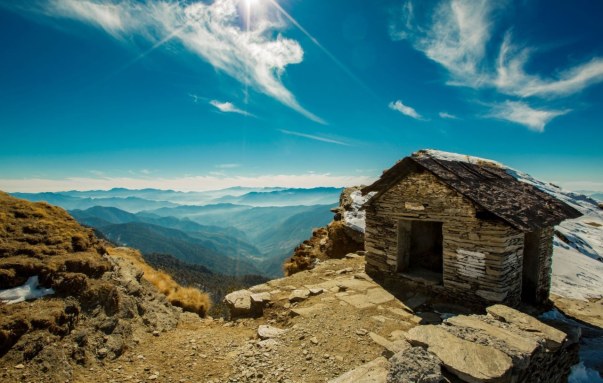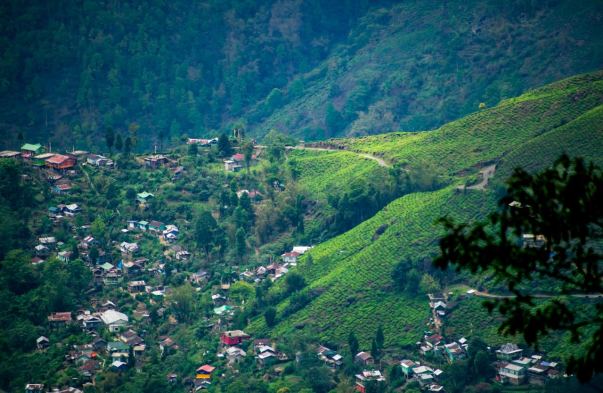We know that climate change is real. Floods, droughts, wildfires, untimely rainfall, decreased snowfall, hotter summers, colder winters – this is evidence that the natural balance has been upset. We need to decarbonize our energy and transport sectors, but we also need to grow more forests to store the carbon we’ve already emitted*.
Over the course of my travels in Uttarakhand (my home state), I’ve learnt that the situation has become increasingly dire over time. Large tracts of forests have been destroyed for timber and fodder, and by forest fires. Erratic weather patterns have caused native crops and fruit trees to stop flourishing. With little food in the forests, the man-animal conflict has grown, with wild boars and monkeys ravaging agricultural fields. Natural springs have dried up and the livelihoods of Himalayan communities are being threatened.
Over the course of my travels in Uttarakhand (my home state), I’ve learnt that the situation has become increasingly dire over time. Large tracts of forests have been destroyed for timber and fodder, and by forest fires. Erratic weather patterns have caused native crops and fruit trees to stop flourishing. With little food in the forests, the man-animal conflict has grown, with wild boars and monkeys ravaging agricultural fields. Natural springs have dried up and the livelihoods of Himalayan communities are being threatened.

Photo: Aditya Siva (Unsplash)
But there is hope. In September 2019, I travelled to Champawat – one of Uttarakhand’s most economically backward districts – to learn about the work of a visionary non-profit organization called Alaap, started by a young female entrepreneur who has been working with rural Himalayan communities for over 6 years. Using the Miyawaki method devised by Japanese scientist Dr Akira Miyawaki, Alaap is creating native forests that grow 30 times denser and upto 10 times faster than regular plantations. I was amazed to see the difference in growth between 2-year-old saplings grown conventionally and by the Miyawaki method; in the latter, nature ensures that plant species share resources and nutrition, aiding faster growth.
But Alaap is not just creating forests. By involving the local communities in growing and conserving these forests, Alaap is generating (temporary) employment, especially for women. It is aiding locals to take ownership of these forests as a means to protect their spring water sources, keep the man-animal conflict at bay, restore the natural ecosystem for better soil and air, and build climate resilience.
But Alaap is not just creating forests. By involving the local communities in growing and conserving these forests, Alaap is generating (temporary) employment, especially for women. It is aiding locals to take ownership of these forests as a means to protect their spring water sources, keep the man-animal conflict at bay, restore the natural ecosystem for better soil and air, and build climate resilience.

I’ve visited a few tree plantation projects in the past years, but Alaap is different because they focus not on monoculture plantations (planting one kind of tree, a common practice in Uttarakhand) but on creating mixed native forests – which not only sequester more carbon but also restore biodiversity in degenerated areas. One of the biggest challenges of planting saplings is ensuring they grow into trees. Forests planted using the Miyawaki technique tend to become self-sustainable within 2 years. The forests planted by Alaap so far have a survival rate of 90%, while only 40% of conventionally planted monocultures are estimated to survive in Uttarakhand.
 Photo: Boudhayan Bardhan (Unsplash)
Photo: Boudhayan Bardhan (Unsplash)I decided to start this fundraiser to support Alaap’s reforestation efforts because deep within, we all love our planet and want to protect its incredible beauty.
WHAT CAN WE DO?
Contribute financially: The funds we raise through this campaign will be used to create 2 community forests in Uttarakhand. Each forest will be planted with 300+ trees, spread over 25 species, and generate temporary employment for 15-17 locals. The money will be used to assess native species with the help of local experts, test the soil, procure seeds and saplings, create / buy nutritional compost, pay labor and maintenance costs, and fence off the forests for protection. Whatever you’re able to donate will go a long way. Please leave your Instagram / twitter ID in your note if you make a contribution, so I can thank you and inspire others to act too!
Join as a volunteer: The forest planting will likely take place in February 2020 during the winter rains. Join the project as a volunteer, get your hands dirty, build a closer connection with nature and experience the stunning beauty and warm hospitality of the far reaches of Uttarakhand. Volunteers will have to bear their own costs and can stay in basic local homestays.
If you have a big patch of land, plant a mixed native forest: If you own a patch of land 100 square meters or bigger, consider growing your own mixed native forest using the Miyawaki technique. Contact organisations like Alaap or Afforestt to learn the technique.
Work towards reducing personal carbon footprint: No matter what naysayers tell you, personal action counts. We can decrease our footprint on earth by making more conscious choices – increasing awareness about the state of the planet, making climate change an election issue, not having kids, turning vegan (or atleast substantially decreasing meat/dairy consumption), flying less, buying less and reducing plastic waste.
Spread the word: The planet needs our voice. Whatever your medium might be – talking, writing, music, photography, design, coding – your voice matters. Spread the word. Discuss and debate solutions. Share this campaign.
Thank you for all your support <3
Love,
Shivya
Connect with Alaap:
Website: Alaap.in
Instagram: @alaapchronicles
Connect with me:
Blog: The Shooting Star
Instagram: @shivya
*The 2018 IPCC (Intergovernmental Panel on Climate Change) report recommends an increase of one billion hectares of forest to limit temperature rise to 1.5° C by 2050. Global tree restoration remains the most effective and affordable solution for carbon removal (Bastin, Jean-Francois, et al 2019). Read more here.
WHAT CAN WE DO?
Contribute financially: The funds we raise through this campaign will be used to create 2 community forests in Uttarakhand. Each forest will be planted with 300+ trees, spread over 25 species, and generate temporary employment for 15-17 locals. The money will be used to assess native species with the help of local experts, test the soil, procure seeds and saplings, create / buy nutritional compost, pay labor and maintenance costs, and fence off the forests for protection. Whatever you’re able to donate will go a long way. Please leave your Instagram / twitter ID in your note if you make a contribution, so I can thank you and inspire others to act too!
Join as a volunteer: The forest planting will likely take place in February 2020 during the winter rains. Join the project as a volunteer, get your hands dirty, build a closer connection with nature and experience the stunning beauty and warm hospitality of the far reaches of Uttarakhand. Volunteers will have to bear their own costs and can stay in basic local homestays.
If you have a big patch of land, plant a mixed native forest: If you own a patch of land 100 square meters or bigger, consider growing your own mixed native forest using the Miyawaki technique. Contact organisations like Alaap or Afforestt to learn the technique.
Work towards reducing personal carbon footprint: No matter what naysayers tell you, personal action counts. We can decrease our footprint on earth by making more conscious choices – increasing awareness about the state of the planet, making climate change an election issue, not having kids, turning vegan (or atleast substantially decreasing meat/dairy consumption), flying less, buying less and reducing plastic waste.
Spread the word: The planet needs our voice. Whatever your medium might be – talking, writing, music, photography, design, coding – your voice matters. Spread the word. Discuss and debate solutions. Share this campaign.
Thank you for all your support <3
Love,
Shivya
Connect with Alaap:
Website: Alaap.in
Instagram: @alaapchronicles
Connect with me:
Blog: The Shooting Star
Instagram: @shivya
*The 2018 IPCC (Intergovernmental Panel on Climate Change) report recommends an increase of one billion hectares of forest to limit temperature rise to 1.5° C by 2050. Global tree restoration remains the most effective and affordable solution for carbon removal (Bastin, Jean-Francois, et al 2019). Read more here.







